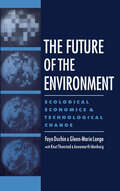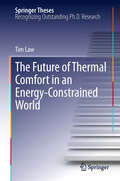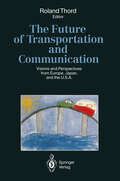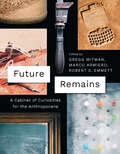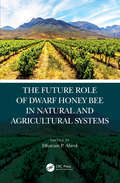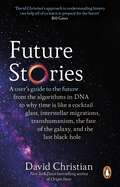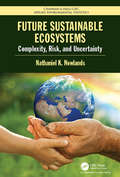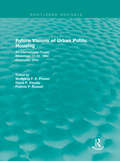- Table View
- List View
The Future Of The Environment: Ecological Economics And Technological Change
by Faye Duchin Glenn-Marie LangeOne of the most important and complex problems facing both developing and industrialized nations is how to sustain economic growth without harming the environment. Faye Duchin and Glenn-Marie Lange address this issue in a practical and realistic way: through a detailed evaluation of the well-known approach to sustainable development outlined in the Brundtland Report,Our Common Future. Taking issue with the Brundtland Report's optimistic and widely accepted assumptions, the authors show that the positive effects of recycling, increased fuel-efficiency, and other technological adjustments will not go far enough to provide for truly sustainable development in the long term. Through a new, broad-based empirical analysis, they argue that unless there are significant changes in lifestyles and the use of technologies, continued environmental degradation cannot be avoided. They warn that the trend of making only slight adjustments in the use of technologies, while feasible from an economic point of view for industrialized nations, will undoubtedly lead to further environmental damage. In addition to offering a clear and unflinching look at what development is really doing to the global environment, the unique conceptual framework developed for this analysis provides an invaluable basis for analysis for the new, multidisciplinary field of ecological economics. Duchin and Lange describe how this new methodology will enable economists and policy-makers to evaluate our options for the future, and choose those that most effectively reduce environmental degradation and achieve sustainable development. The book will appeal to economists, environmental scientists and activists, policy analysts, and ecologists, as well as the general reader with an interest in the sustainable development of our environment.
The Future of the Environment: The Social Dimensions Of Conservation And Ecological Alternatives (European Year Of The Environment Ser.)
by David PittA major concern of this book is how ordinary people might come to manage their own environment more effectively. A valuable resource for students of environmental studies, it considers how this might be facilitated by more appropriate technology, assistance and communications. Reviewed by the International Journal of Environmental Studies, it has`... something of interest and information in every chapter of this book and I urge all readers to look at it carefully, for its combination of the examination of general principles and down-to-earth data and problems is one of the best for years'.
The Future of the Environment
by David PittA major concern of this book is how ordinary people might come to manage their own environment more effectively. A valuable resource for students of environmental studies, it considers how this might be facilitated by more appropriate technology, assistance and communications. Reviewed by the International Journal of Environmental Studies, it has`... something of interest and information in every chapter of this book and I urge all readers to look at it carefully, for its combination of the examination of general principles and down-to-earth data and problems is one of the best for years'.
The Future of the Red-legged Partridge: Science, Hunting and Conservation (Wildlife Research Monographs #6)
by Fabián Casas Jesús T. GarcíaThere has been a recent upsurge of red-legged partridge research in most countries where the species is distributed, but no comprehensive review of that fresh and relevant multidisciplinary and international knowledge is available. In fact, this is probably the first scientific book on this important species, apart from Dick Potts’ excellent works on British-introduced population, or ONCFS’s (Office Nationale de la Chasse et le Faune Sauvage, France) older technical reports. This is in strong contrast with a plethora of literature in hunting magazines or non-academic books, not often precise, realistic, or well informed. Thus, the book fills a great bibliography gap that could have important social impact. The common thread of the book is the prominent role a species like this may play for research, from basic physiological or ecological knowledge to socio-economics of hunting and the rural world. The general framework of the book [I1] is the important role that hunting and game management may play in both rural economies and biodiversity conservation, with the partridge as flag species, and also in identifying the “dark drift” that industrial, incorrectly deployed management, or hunting vision may have on both sustainability of resources and nature conservation at large. The final aim of the book is identifying the best future scenario, both for partridge hunters and managers as well as the general public.
The Future of the Suburban City: Lessons from Sustaining Phoenix
by Grady GammageAs a Phoenix native, the author argues that the suburban city, which grew up based on the automobile and the single‑family home, needs to dramatically change and evolve in an era of climate change. He shows how this is possible, and that many suburban cities are already making strides in increasing their resilience. Gammage focuses on the story of Phoenix, which shows the power of collective action — government action — to confront the challenges of geography and respond through public policy. He examines issues facing most suburban cities around water supply, heat, transportation, housing, density, urban form, jobs, economics, and politics.This book is a realistic yet hopeful story of what is possible for any suburban city.
The Future of the UN Sustainable Development Goals: Business Perspectives for Global Development in 2030 (CSR, Sustainability, Ethics & Governance)
by Samuel O. Idowu René Schmidpeter Liangrong ZuThis book provides a business-oriented analysis of the United Nations (UN) Sustainable Development Goals (SDG). In order to assess their impact on businesses and corporations, the book addresses all 17 goals and a broad range of industries. Gathering contributions from Africa, Europe and Asia, it presents both critical reviews and case studies. In turn, the book seeks to predict likely developments during the next decade. To do so, it examines evidence from today’s business world and how companies and corporations have been adopting the SDGs since their release. In this regard, it discusses the changes that will be required and how the agenda will affect the continent’s development path. An underlying theme throughout the book is the role of monetary value and investment for sustainable development: whether through financing, enhanced turnaround resulting from a more educated population, or more socially innovative entrepreneurs.
The Future of Thermal Comfort in an Energy- Constrained World (Springer Theses)
by Tim LawThe dissertation investigates the scientific and business factors that have resulted in air-conditioning being a major contributor to climate-change. With his architectural background, the author demonstrates how a design methodology, not commonly adopted in scientific studies, may actually be a suitable way of dealing with a complex problem: the 'business as usual' scenario involving building science, sociological values and consumer behavior. Using his innovations as case studies, the author shows how good ideas cannot be evaluated on scientific merit alone and demonstrates why commercialization may have a pivotal role in deployment of research-based technology. He advances the theory of personalized thermal comfort which can potentially resolve the air-conditioning conundrum.
The Future of Transportation and Communication: Visions and Perspectives from Europe, Japan, and the U.S.A.
by A. E. Andersson K. Button H. G. Forsberg B. Johansson P. Kiselev K. Kobayashi K. R. Kunzmann T. D. Larson K. Lindahl-Kiessling H. Sandhäger R. J. Schonberger L. Schotte K. A. Small F. Snickars Roland Thord W. Westerhuis K. YoshikawaWe all know that networks are fundamental prerequisites for prosperity and production. Transportation and communication are indispensible to society, they are the elements which bind all economic systems together. Without networks and communica tion all social and economic life will be reduced to isolated phenomena. Therefore, transportation can't be assessed in the same way as other services. A smoothly functioning system of communications is also a prerequistite for social and economic integration between separate geographical regions. The modernization of the infrastructure is therefore an urgent task and a precondition for carrying out the whole of Europe's ambitious political, economic and social agenda. Since the need for communication and transportation does not know any national borders, the functioning of the networks needs to be adopted to this new economic and political geography. Congestions of cities, highways, railroads, airways and tele communications must be tackled, if precious working, commuting and leisure time is not to be wasted and heavy burdens on the environment avoided. European traffic, is for example, expected to double within the next twenty years. In certain transport modes the growth is expected to be even faster - air passenger transport doubled in 10 years and goods transport on roads doubled in 15 years.
Future Ready: Your Organization's Guide to Rethinking Climate, Resilience, and Sustainability
by Tom Lewis Alastair MacGregorRethink climate, resilience, and sustainability for your organization In Future Ready: Your Organization’s Guide to Rethinking Climate, Resilience, and Sustainability, a team of business leaders with deep expertise in engineering, planning, finance, project, program implementation and advisory consulting perspective delivers an essential guide for executives, managers, and other business and infrastructure organization leaders to set and implement a resilience, sustainability and ESG strategy in complex project and operating environments. Through practical examples and proven insights, readers will learn to proactively engage with stakeholders, successfully plan, implement, and measure the impacts of their initiatives, and effectively communicate the results. In the book, the authors draw on hundreds of completed projects across a full range of client organizations, markets, sectors, and scales to equip readers with unprecedented insights and the behind-the-scenes work that went into making the projects successful. The authors also include: Strategies for identifying, cataloguing, and reporting risks—from the operational to the physical and transactional—as well as explanations of how climate risk scenarios can reveal hidden opportunities and unexpected vulnerabilities A Future Ready mindset and the specific examples of organizational sustainability and climate adaptation commitments and the paths companies have taken to meet their goals Critical questions that leaders must ask of themselves and their organizations before they begin a climate, resilience, and/or sustainability initiativeA must-read guide for executives, board members, ESG professionals, and other business and infrastructure organization leaders, Future Ready belongs in the hands of anyone who finds themselves responsible for helping an organization achieve their environmental, social, and governance goals.
Future Ready: Your Organization's Guide to Rethinking Climate, Resilience, and Sustainability
by Tom Lewis Alastair MacGregorRethink climate, resilience, and sustainability for your organization In Future Ready: Your Organization’s Guide to Rethinking Climate, Resilience, and Sustainability, a team of business leaders with deep expertise in engineering, planning, finance, project, program implementation and advisory consulting perspective delivers an essential guide for executives, managers, and other business and infrastructure organization leaders to set and implement a resilience, sustainability and ESG strategy in complex project and operating environments. Through practical examples and proven insights, readers will learn to proactively engage with stakeholders, successfully plan, implement, and measure the impacts of their initiatives, and effectively communicate the results. In the book, the authors draw on hundreds of completed projects across a full range of client organizations, markets, sectors, and scales to equip readers with unprecedented insights and the behind-the-scenes work that went into making the projects successful. The authors also include: Strategies for identifying, cataloguing, and reporting risks—from the operational to the physical and transactional—as well as explanations of how climate risk scenarios can reveal hidden opportunities and unexpected vulnerabilities A Future Ready mindset and the specific examples of organizational sustainability and climate adaptation commitments and the paths companies have taken to meet their goals Critical questions that leaders must ask of themselves and their organizations before they begin a climate, resilience, and/or sustainability initiativeA must-read guide for executives, board members, ESG professionals, and other business and infrastructure organization leaders, Future Ready belongs in the hands of anyone who finds themselves responsible for helping an organization achieve their environmental, social, and governance goals.
Future Remains: A Cabinet of Curiosities for the Anthropocene
by Gregg Mitman Marco Armiero Robert EmmettWhat can a pesticide pump, a jar full of sand, or an old calico print tell us about the Anthropocene—the age of humans? Just as paleontologists look to fossil remains to infer past conditions of life on earth, so might past and present-day objects offer clues to intertwined human and natural histories that shape our planetary futures. In this era of aggressive hydrocarbon extraction, extreme weather, and severe economic disparity, how might certain objects make visible the uneven interplay of economic, material, and social forces that shape relationships among human and nonhuman beings? Future Remains is a thoughtful and creative meditation on these questions. The fifteen objects gathered in this book resemble more the tarots of a fortuneteller than the archaeological finds of an expedition—they speak of planetary futures. Marco Armiero, Robert S. Emmett, and Gregg Mitman have assembled a cabinet of curiosities for the Anthropocene, bringing together a mix of lively essays, creatively chosen objects, and stunning photographs by acclaimed photographer Tim Flach. The result is a book that interrogates the origins, implications, and potential dangers of the Anthropocene and makes us wonder anew about what exactly human history is made of.
Future Remains: A Cabinet of Curiosities for the Anthropocene
by Gregg Mitman Marco Armiero Robert EmmettWhat can a pesticide pump, a jar full of sand, or an old calico print tell us about the Anthropocene—the age of humans? Just as paleontologists look to fossil remains to infer past conditions of life on earth, so might past and present-day objects offer clues to intertwined human and natural histories that shape our planetary futures. In this era of aggressive hydrocarbon extraction, extreme weather, and severe economic disparity, how might certain objects make visible the uneven interplay of economic, material, and social forces that shape relationships among human and nonhuman beings? Future Remains is a thoughtful and creative meditation on these questions. The fifteen objects gathered in this book resemble more the tarots of a fortuneteller than the archaeological finds of an expedition—they speak of planetary futures. Marco Armiero, Robert S. Emmett, and Gregg Mitman have assembled a cabinet of curiosities for the Anthropocene, bringing together a mix of lively essays, creatively chosen objects, and stunning photographs by acclaimed photographer Tim Flach. The result is a book that interrogates the origins, implications, and potential dangers of the Anthropocene and makes us wonder anew about what exactly human history is made of.
Future Remains: A Cabinet of Curiosities for the Anthropocene
by Gregg Mitman Marco Armiero Robert S. EmmettWhat can a pesticide pump, a jar full of sand, or an old calico print tell us about the Anthropocene—the age of humans? Just as paleontologists look to fossil remains to infer past conditions of life on earth, so might past and present-day objects offer clues to intertwined human and natural histories that shape our planetary futures. In this era of aggressive hydrocarbon extraction, extreme weather, and severe economic disparity, how might certain objects make visible the uneven interplay of economic, material, and social forces that shape relationships among human and nonhuman beings? Future Remains is a thoughtful and creative meditation on these questions. The fifteen objects gathered in this book resemble more the tarots of a fortuneteller than the archaeological finds of an expedition—they speak of planetary futures. Marco Armiero, Robert S. Emmett, and Gregg Mitman have assembled a cabinet of curiosities for the Anthropocene, bringing together a mix of lively essays, creatively chosen objects, and stunning photographs by acclaimed photographer Tim Flach. The result is a book that interrogates the origins, implications, and potential dangers of the Anthropocene and makes us wonder anew about what exactly human history is made of.
Future Remains: A Cabinet of Curiosities for the Anthropocene
by Gregg Mitman Marco Armiero Robert S. EmmettWhat can a pesticide pump, a jar full of sand, or an old calico print tell us about the Anthropocene—the age of humans? Just as paleontologists look to fossil remains to infer past conditions of life on earth, so might past and present-day objects offer clues to intertwined human and natural histories that shape our planetary futures. In this era of aggressive hydrocarbon extraction, extreme weather, and severe economic disparity, how might certain objects make visible the uneven interplay of economic, material, and social forces that shape relationships among human and nonhuman beings? Future Remains is a thoughtful and creative meditation on these questions. The fifteen objects gathered in this book resemble more the tarots of a fortuneteller than the archaeological finds of an expedition—they speak of planetary futures. Marco Armiero, Robert S. Emmett, and Gregg Mitman have assembled a cabinet of curiosities for the Anthropocene, bringing together a mix of lively essays, creatively chosen objects, and stunning photographs by acclaimed photographer Tim Flach. The result is a book that interrogates the origins, implications, and potential dangers of the Anthropocene and makes us wonder anew about what exactly human history is made of.
Future Remains: A Cabinet of Curiosities for the Anthropocene
by Gregg Mitman Marco Armiero Robert S. EmmettWhat can a pesticide pump, a jar full of sand, or an old calico print tell us about the Anthropocene—the age of humans? Just as paleontologists look to fossil remains to infer past conditions of life on earth, so might past and present-day objects offer clues to intertwined human and natural histories that shape our planetary futures. In this era of aggressive hydrocarbon extraction, extreme weather, and severe economic disparity, how might certain objects make visible the uneven interplay of economic, material, and social forces that shape relationships among human and nonhuman beings? Future Remains is a thoughtful and creative meditation on these questions. The fifteen objects gathered in this book resemble more the tarots of a fortuneteller than the archaeological finds of an expedition—they speak of planetary futures. Marco Armiero, Robert S. Emmett, and Gregg Mitman have assembled a cabinet of curiosities for the Anthropocene, bringing together a mix of lively essays, creatively chosen objects, and stunning photographs by acclaimed photographer Tim Flach. The result is a book that interrogates the origins, implications, and potential dangers of the Anthropocene and makes us wonder anew about what exactly human history is made of.
Future Remains: A Cabinet of Curiosities for the Anthropocene
What can a pesticide pump, a jar full of sand, or an old calico print tell us about the Anthropocene—the age of humans? Just as paleontologists look to fossil remains to infer past conditions of life on earth, so might past and present-day objects offer clues to intertwined human and natural histories that shape our planetary futures. In this era of aggressive hydrocarbon extraction, extreme weather, and severe economic disparity, how might certain objects make visible the uneven interplay of economic, material, and social forces that shape relationships among human and nonhuman beings? Future Remains is a thoughtful and creative meditation on these questions. The fifteen objects gathered in this book resemble more the tarots of a fortuneteller than the archaeological finds of an expedition—they speak of planetary futures. Marco Armiero, Robert S. Emmett, and Gregg Mitman have assembled a cabinet of curiosities for the Anthropocene, bringing together a mix of lively essays, creatively chosen objects, and stunning photographs by acclaimed photographer Tim Flach. The result is a book that interrogates the origins, implications, and potential dangers of the Anthropocene and makes us wonder anew about what exactly human history is made of.
The Future Role of Dwarf Honey Bees in Natural and Agricultural Systems
by D. P. AbrolThe future role of dwarf honeybees in natural and agricultural systems provides multidisciplinary perspective about the different facets of dwarf honeybees. The role of dwarf honeybee Apis florea assumes utmost importance in the context of pollinator decline throughout the world threatening stability of ecosystems and global food security. Apis florea is a low land species of south Asia extending more to the west than other Asiatic Apis species. It is an important pollinator of crops in hot and dry agricultural plains. The book is first of its kind which deals in details on varied aspects of Apis florea biology, management, conservation strategies for protecting biodiversity and enhancing crop productivity. The book aims to promote a large, diverse, sustainable, and dependable bee pollinator workforce that can meet the challenge for optimizing food production well into the 21st century. Features: Apis florea provides source of livelihood in mountainous areas and marginal farmers. This book will for the first time present the beekeeping from the perspective of agricultural production and biodiversity conservation An excellent source of advanced study material for academics, researchers and students and programme planners Excellent pollinator of tropical and subtropical crops fruits vegetables etc less prone to diseases and enemies Covering the latest information on various aspects of Apis florea biology, this book brings the latest advances together in a single volume for researchers and advanced level students This book will be useful to pollination biologists, honeybee biologists in entomology departments, students, teachers, scientists of agriculture, animal behaviour, botany, conservation, biology, ecology, entomology, environmental biology, forestry, genetics, plant breeding, horticulture, toxicology, zoology, seed growers and seed agencies and shall serve as reference book for students, teachers, researchers, extension functionaries and policy planners.
The Future Role of Dwarf Honey Bees in Natural and Agricultural Systems
by Dharam P. AbrolThe future role of dwarf honeybees in natural and agricultural systems provides multidisciplinary perspective about the different facets of dwarf honeybees. The role of dwarf honeybee Apis florea assumes utmost importance in the context of pollinator decline throughout the world threatening stability of ecosystems and global food security. Apis florea is a low land species of south Asia extending more to the west than other Asiatic Apis species. It is an important pollinator of crops in hot and dry agricultural plains. The book is first of its kind which deals in details on varied aspects of Apis florea biology, management, conservation strategies for protecting biodiversity and enhancing crop productivity. The book aims to promote a large, diverse, sustainable, and dependable bee pollinator workforce that can meet the challenge for optimizing food production well into the 21st century. Features: Apis florea provides source of livelihood in mountainous areas and marginal farmers. This book will for the first time present the beekeeping from the perspective of agricultural production and biodiversity conservation An excellent source of advanced study material for academics, researchers and students and programme planners Excellent pollinator of tropical and subtropical crops fruits vegetables etc less prone to diseases and enemies Covering the latest information on various aspects of Apis florea biology, this book brings the latest advances together in a single volume for researchers and advanced level students This book will be useful to pollination biologists, honeybee biologists in entomology departments, students, teachers, scientists of agriculture, animal behaviour, botany, conservation, biology, ecology, entomology, environmental biology, forestry, genetics, plant breeding, horticulture, toxicology, zoology, seed growers and seed agencies and shall serve as reference book for students, teachers, researchers, extension functionaries and policy planners.
Future Satellite Gravimetry and Earth Dynamics
by Jakob Flury Reiner RummelNew and more accurate techniques for satellite gravimetry will be available soon, with promising applications in Earth sciences. With this special issue the authors want to stimulate discussion among Earth scientists on objectives and preferences for future satellite gravimetry missions. This is an urgently needed discussion. Visions for follow-on missions have to be developed today, if they are to be realized within 10 years, given the required preparation time of such satellite missions.
Future Sea: How to Rescue and Protect the World’s Oceans
by Deborah Rowan WrightThe world’s oceans face multiple threats: the effects of climate change, pollution, overfishing, plastic waste, and more. Confronted with the immensity of these challenges and of the oceans themselves, we might wonder what more can be done to stop their decline and better protect the sea and marine life. Such widespread environmental threats call for a simple but significant shift in reasoning to bring about long-overdue, elemental change in the way we use ocean resources. In Future Sea, ocean advocate and marine-policy researcher Deborah Rowan Wright provides the tools for that shift. Questioning the underlying philosophy of established ocean conservation approaches, Rowan Wright lays out a radical alternative: a bold and far-reaching strategy of 100 percent ocean protection that would put an end to destructive industrial activities, better safeguard marine biodiversity, and enable ocean wildlife to return and thrive along coasts and in seas around the globe. Future Sea is essentially concerned with the solutions and not the problems. Rowan Wright shines a light on existing international laws intended to keep marine environments safe that could underpin this new strategy. She gathers inspiring stories of communities and countries using ocean resources wisely, as well as of successful conservation projects, to build up a cautiously optimistic picture of the future for our oceans—counteracting all-too-prevalent reports of doom and gloom. A passionate, sweeping, and personal account, Future Sea not only argues for systemic change in how we manage what we do in the sea, but also describes steps that anyone, from children to political leaders (or indeed, any reader of the book), can take toward safeguarding the oceans and their extraordinary wildlife.
Future Stories: A user's guide to the future
by David Christian'David Christian's approach to understanding history can help all of us learn to prepare for the future' - Bill GatesA user's guide to the future: from the algorithms in DNA to why time is like a cocktail glass, interstellar migrations, transhumanism, the fate of the galaxy, and the last black hole...Every second of our lives - whether we're looking both ways before crossing the street, celebrating the birth of a baby, or moving to a new city - we must cope with an unknowable future by telling stories about what will happen next. Where is the future, the place where we set those stories? Can we trust our future stories? And what sort of futures do they show us?David Christian, historian and bestselling author of Origin Story, is renowned for pioneering the emerging discipline of Big History, which surveys the whole of the past. But with Future Stories, he casts his sharp analytical eye forward, offering an introduction to the strange world of the future, and a guide to what we think we know about it at all scales, from the predictive mechanisms of single-celled organisms and tomato plants to the merging of colossal galaxies billions of years from now.Drawing together science, history and philosophy from a huge range of places and times, Christian explores how we prepare for uncertain futures, including the future of human evolution, artificial intelligence, interstellar travel, and more. By linking the study of the past much more closely to the study of the future, we can begin to imagine what the world will look like in the next hundred years and consider solutions to the biggest challenges facing us all.
Future Sustainable Ecosystems: Complexity, Risk, and Uncertainty (Chapman & Hall/CRC Applied Environmental Statistics)
by Nathaniel K NewlandsFuture Sustainable Ecosystems: Complexity, Risk, Uncertainty provides an interdisciplinary, integrative overview of environmental problem-solving using statistics. It shows how statistics can be used to solve diverse environmental and socio-economic problems involving food, water, energy scarcity, and climate change risks. It synthesizes interdisciplinary theory, concepts, definitions, models and findings involved in complex global sustainability problem-solving, making it an essential guide and reference. It includes real-world examples and applications making the book accessible to a broader interdisciplinary readership. Discussions include a broad, integrated perspective on sustainability, integrated risk, multi-scale changes and impacts taking place within ecosystems worldwide. State-of-the-art statistical techniques, including Bayesian hierarchical, spatio-temporal, agent-based and game-theoretic approaches are explored. The author then focuses on the real-world integration of observational and experimental data and its use within statistical models.
Future Sustainable Ecosystems: Complexity, Risk, and Uncertainty (Chapman & Hall/CRC Applied Environmental Statistics)
by Nathaniel K NewlandsFuture Sustainable Ecosystems: Complexity, Risk, Uncertainty provides an interdisciplinary, integrative overview of environmental problem-solving using statistics. It shows how statistics can be used to solve diverse environmental and socio-economic problems involving food, water, energy scarcity, and climate change risks. It synthesizes interdisciplinary theory, concepts, definitions, models and findings involved in complex global sustainability problem-solving, making it an essential guide and reference. It includes real-world examples and applications making the book accessible to a broader interdisciplinary readership. Discussions include a broad, integrated perspective on sustainability, integrated risk, multi-scale changes and impacts taking place within ecosystems worldwide. State-of-the-art statistical techniques, including Bayesian hierarchical, spatio-temporal, agent-based and game-theoretic approaches are explored. The author then focuses on the real-world integration of observational and experimental data and its use within statistical models.
Future Sustainable Urban Freight Network Design in the Large Cities and Megacities (Sustainable Management, Wertschöpfung und Effizienz)
by Zhangyuan HeThis book aims to investigate a long-term strategy for sustainable urban logistics. The literature evidence exhibits that considerable research on urban logistics lacks long-term planning and rarely considers the urban spatial development and integration of urban distribution innovations. Currently, 11 distribution innovations can be used for future sustainable urban freight transport. According to a systematic discussion, this book formulates the conceptual model of Sustainable Inner-urban Intermodal Transportation (SIUIT) for future urban logistics. Moreover, a comprehensive analysis illustrates that future integrations of distribution innovations comprise operational and technological integration. To this end, the morphological analysis method is employed to discuss their feasible solutions based on the SIUIT model. After that, combined with the trend exploration of urban spatial development on large- and megacities, this book constructs the 2.x Modula & Sustainable Urban Freight Network to improve the flexibility of the future sustainable logistics transformation.About the AuthorDr. rer. pol. Zhangyuan He graduated from the University of Bremen. He currently undertakes postdoctoral research at the School of Urban Planning and Design, Peking University.
Future Visions of Urban Public Housing: An International Forum, November 17-20, 1994 (Routledge Revivals)
by Wolfgang F. E. Preiser David P. Varady Francis P. RussellFirst published in 1994, this book brings together the papers presented at the International Forum on ‘Future Visions of Urban Public Housing’ held on November 17-20, 1994 in Cincinnati, Ohio. Participants included public housing officials, academics, practitioners and public housing residents who came together to debate, compare and analyse practices and issues in urban and public housing in industrialised nations. The 55 collected papers address the following key topics: public housing policy; comprehensive neighbourhood planning for public housing; public housing in the urban design context; quality of design standards and guidelines for public housing; resident participation and enhanced self-sufficiency in public housing; public housing alternatives; revitalising and rehabilitating public housing; the Elderly, Children, and special populations in public housing. The findings suggest new directions for policy and agendas for action.
